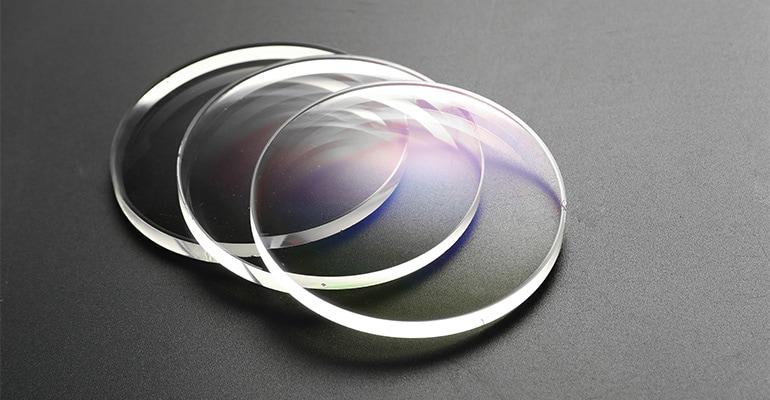Types of Glasses: A Guide to Frames, Lenses, and Coatings
Mar 19, 2024

Glasses serve a dual purpose in your life: they correct vision and express personal style. Whether you need them for reading, distance viewing, or computer work, glasses come with a plethora of lens options. Single-vision lenses can correct nearsightedness or farsightedness, while multifocal lenses, like bifocals or trifocals, handle multiple vision problems in one lens. Progressive lenses, offering a gradient of various prescriptions, cater to all distances without the visible lines found in bifocals.
Frame shapes and styles matter too; they pair functionality with fashion. The rectangle, round, square, or even the trendy geometric frames could outline your face to accentuate your best features.
Choosing the right pair can feel overwhelming, but understanding the types of glasses and how they align with your visual needs and lifestyle preferences eases the process. Examining different frame styles is not just about how they look on your face, but also how they fit into your everyday life. This guide is created to help you navigate the wide world of eyewear with the hopes of making your next pair not just a necessity but a highlight of your personal style.
Glasses Styles and Shapes
Choosing the right glasses involves more than just lens clarity—it's about fashion and how they fit your face. Each style has unique characteristics, and the right shape can enhance your best features.
Rectangle Frames
Rectangle frames offer a classic style that provides a balance to rounder face shapes. These frames are characterized by their angular lines and can make your face appear longer.
Square Frames
Square frames are a bold choice, suiting those with round or oval faces. They're defined by their four equal sides and can add structure to your features.
Round Frames
For a soft and vintage look, round frames are ideal. They work well with angular face shapes, such as square or rectangle, adding a contrast to sharp features.
Oval Frames
Oval frames are versatile and work well with most face shapes, particularly those with sharper angles. Their curved edges offer a gentle aesthetic.
Cat-Eye Frames
Cat-eye frames are known for their upswept angles and add a touch of elegance to your look. They're particularly flattering if you have a heart-shaped face and want to accentuate your cheekbones.
Wayframe Frames
Wayframe frames have a trapezoidal shape and are timeless. Suitable for a variety of face shapes, they provide a casual feel that's both stylish and approachable.
Aviator Frames
Aviator frames feature a teardrop shape that can add an edge to your appearance. They are especially fitting for those with square or rectangle faces, as they soften the jawline.
Browline Frames
Browline frames are marked by their accentuated upper portion, which mimics the natural browline. They're ideal for oval and round faces, lending a distinguished look.
Types of Glasses Frames
When selecting the material for your glasses frames, consider durability, weight, and skin sensitivity. Here's a breakdown of the different materials to help you make an informed choice.
Titanium
Titanium frames are known for their strength, durability, and corrosion resistance. Lightweight and hypoallergenic, they're ideal if you prioritize comfort and have skin sensitivities.
Stainless Steel
Stainless steel frames offer a good balance between durability and cost. They're resistant to corrosion and provide a sleek look, which makes them a popular choice for everyday wear.
Aluminum
Aluminum frames are light and strong, boasting a high strength-to-weight ratio. They often have a unique, industrial aesthetic and they resist corrosion effectively.
Acetate
Acetate frames are known for their rich colors and patterns. This material is made from renewable resources and can offer a comfortable fit due to its flexibility.
Polycarbonate
Frames made of polycarbonate are lightweight and impact-resistant, making them a solid option if you're looking for durability without added weight.
Nylon
Nylon frames are generally flexible and resistant to heat and cold, which makes them great for sports eyewear. However, they may become brittle with age.
Combination Frames
Combination frames use multiple materials, such as metal with acetate or plastic, allowing for creative designs and enhanced features like added strength or decorative elements.
Rimless and Semi-Rimless Frames
Rimless and Semi-Rimless Frames offer a minimalistic look. Rimless frames have no frame around the lens, while semi-rimless frames only have a frame on part of the lens, typically the top or sides.
Factors to Consider When Choosing Frame Materials
When choosing frame materials, weigh factors like:
-
Durability: How long do you expect your frames to last?
-
Weight: Do you prefer a heavier feel or a barely-there sensation?
-
Skin Sensitivity: Does your skin react to certain metals or materials?
-
Style Preference: Are you going for a bold statement or a classic look?
-
Budget: What price range are you looking at for your frames?
Select the material that will best suit your lifestyle and aesthetic preferences. Each has its own set of benefits, so consider what's most important for your comfort and needs.

Lenses and Coatings
When selecting glasses, the material of the lenses and the types of coatings applied are crucial to the performance and longevity of your eyewear.
Lens Materials
-
Glass: Once the standard, glass is less common now due to its weight and fragility.
-
Polycarbonate: A lightweight and impact-resistant choice ideal for sports and active lifestyles.
-
CR-39 Plastic: A common plastic lens that's lighter than glass and offers clear vision.
Lens Coatings and Treatments
-
Scratch-resistant coating: Applied to both sides of lenses to protect them from scratches.
-
Anti-reflective (AR) coating: Reduces glare, lessens reflections, and improves the clarity of the lens.
Benefits and Drawbacks of Each Lens Material and Coating
| Material/Coating | Benefits | Drawbacks |
| Glass | High optical clarity | Heavy and breaks easily |
| Polycarbonate | Light, very impact-resistant, good for active use | Less scratch-resistant than glass without coating |
| CR-39 Plastic | Lighter than glass, more affordable | Not as impact-resistant as polycarbonate |
| Scratch-resistant | Prolongs lens life, clearer vision | Not 100% scratch-proof |
| Anti-reflective | Reduces eye strain, improves aesthetic | Can be hard to clean |
Lenses and coatings can fundamentally alter your experience with your eyewear. Your choices should be informed by your lifestyle and vision needs.
Conclusion
Choosing the perfect pair of glasses can significantly enhance your everyday comfort and style. Remember, the right frames are out there for you, and it's all about finding a balance between comfort, durability, and aesthetics. Here are some key takeaways:
-
Material Matters: Whether you opt for metal (e.g., titanium, stainless steel) or plastic frames, consider your lifestyle and any skin sensitivities.
-
Style Selection: Glasses come in a vast array of styles like geometric, classic round, or square. Choose one that complements your face shape and personality.
-
Specialized Options: Don't forget about specialty glasses such as blue light blocking or computer glasses to protect your eyes from screen glare and fatigue.
Your glasses are an extension of your personal style, so invest time in selecting frames that make you feel confident. Feel free to experiment until you find that perfect pair that suits your needs and lets you see the world clearly. Remember, glasses are not just a vision aid but also a fashion statement. Enjoy the process!